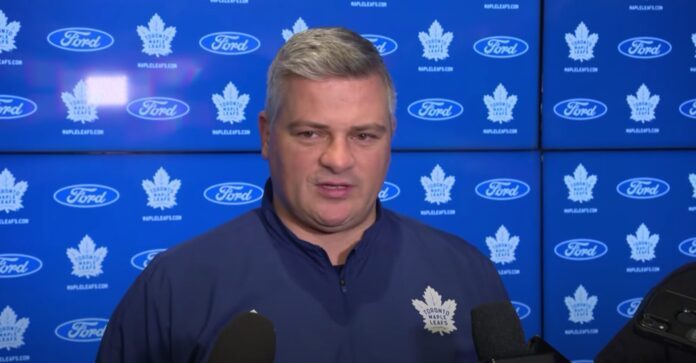
After Tuesday’s practice, head coach Sheldon Keefe discussed Timothy Liljegren’s rough game against Boston, the scoring chances given up on the power play recently, and Conor Timmins and David Kampf’s status in their recovery from illness.
Practice Lines – Mar. 5
Lines at Leafs practice
Knies – Matthews – Marner
Bertuzzi – Domi – Nylander
McMann – Tavares – Jarnkrok
Gregor – Holmberg – ReavesRielly – Lyubushkin
Brodie – Liljegren
Benoit – McCabe
Lagesson – TimminsSamsonov
Woll
JonesHost Sabres Wednesday @TSN_Edge
— Mark Masters (@markhmasters) March 5, 2024
What do you want Timothy Liljegren to take away from how the game against Boston played out?
Keefe: He has to dust himself off and get ready for the next game. We have four games in six nights this week. We are right back at it tomorrow. There is no time for anything other than preparing for the next one.
We have given him a great opportunity here — one we thought he was building some positive momentum and doing well with. When you take a step back or slip a little bit, you just have to be confident in the good things that you have done.
What have you seen from William Nylander’s line so far? What potential do you see that makes you want to give them the runway?
Keefe: We just think that the offensive skills and characteristics of the line make up a line that can be effective.
It also has effects on the rest of the lineup. Our ability to have John on a different line sets us up well. We are seeing some of the positive things that are coming out of that. It is all connected. For those reasons, you want to stick with it.
Also, the team has played well. The team has had good results. You want to be able to continue to work with it and let it breathe a little bit, but you are obviously monitoring it at the same time.
With the trade deadline fast approaching, what does the week look like in terms of liaising with Brad Treliving?
Keefe: For me, it hasn’t been any different. I meet with Brad daily and we chat. We go through different things. All season, he has done a good job of keeping me informed and asking questions while, at the same time, allowing me to focus on the team and the group.
This is a very busy week for us as a coaching staff. I have enough on my plate.
You had a conversation with Pontus Holmberg at the end of practice. Has your trust level in him grown in the last few weeks?
Keefe: It has. The conversation was more of a reminder of the fact that if you want to play in the league every day on a good team, you have to bring it all the time. In the last couple of games, as we have come back from the road trip — while we have liked his line, liked his game, and we believe in him — he has slipped a little bit.
On the first goal, in particular, he had an opportunity to kill a play early for us before they had a chance to get anywhere near our net. It is the type of play that I expect all of our players to manage in that situation, particularly for a young, hungry guy who is looking to solidify his place on the team and in the league. That is a spot that he has to be great in. He wasn’t.
In those cases, we need more. That is the difference between those that solidify themselves in the league and those that don’t.
Why do you think the power play has been so susceptible to the counterattack during this recent stretch?
Keefe: Some of the teams we’ve played have that as part of their plan. They really push and strike when you open the door for them to do so. We have been caught a little bit on that.
In the case of last night, I think there is also some frustration with the breakouts and inability to get set, which leads to a little more fatigue and having to go up and down the ice. We got a little disconnected there.
Liljegren was out there as one of our fresh guys, and I don’t think he managed it well. The puck goes to Joseph (Woll), and he needs to put it in a good spot but fails to do that. Things compounded a little bit. Boston recognized we were vulnerable and took advantage of it.
The team hasn’t scored a power-play goal on Boston in six straight games. What do you make of that?
Keefe: It is a very good penalty kill and has been for a number of years.
Aside from our first power play yesterday, we had several grade-A chances for our power play. On one of them, they pulled it off of the goal line. Morgan hit the post in the third period. These kinds of things sometimes happen.
I think it has a little more to do with us than the opponent. I don’t think you can do too much with stats that you pull when you play a team once every 40 games.
William Nylander has mentioned that he thinks his line has been caught defending tired at times. How much do you think better line changes or better timing on the line changes can help them in that department?
Keefe: That is kind of the art of being a good defensive player: getting off the ice before things go badly. That is part of it, yes.
It is a challenging thing to do for offensive players. You build momentum on a shift. You want to produce. You want to score. You want to see it through, but when things don’t work out, you have to get back and defend the other way.
It is always a challenge for offensive players. It is always a balance, right? As a coach, you are combatting it. You want guys to produce and you want guys to feel good on offense, but you want to build positive momentum as a team from shift to shift. In some cases, that requires giving up on your shift. When you have guys who are expected to produce and want to produce, guys may ask questions when they don’t produce. It is hard for them to give up on their shift and recognize these things.
Some of it is the shift length. Some of it is execution on breakouts. If you don’t break out on the first time really quick, now you are in the defensive zone. If you can manage your shift well by getting in and out fast from our breakouts, that is another piece that allows you to get a line change and get out. If you don’t get out the first time, now you are chasing.
That was a bit of a focus for us here today in practice in the short time we were out there. For that line, in particular, it is probably a more important factor than the line change piece. I think there is something to the line change issue, but there is a natural flow to the game that you can’t prevent. It is going to happen in spots, but the execution on our half of the ice with the puck is an important piece. If you don’t get it right, now you are going to be in the defensive zone and it exposes other issues.
Conor Timmins says he is close to 100%. Where does his availability stand and could he get back into the lineup soon?
Keefe: We will see. Today was his first practice, but I thought he did look good. It is the first time he has been cleared for contact. He has been skating a fair bit on his own.
Today is the first real practice, and we don’t have any practices remaining this week. To that end, it is hard to really judge exactly where he is at or put him right in the mix. We will see how it goes.
It is a matter of Timmins waiting for his opportunity at this point?
Keefe: Yeah, it is a combination of waiting for his opportunity but also getting ready. He hasn’t played in quite some time here. Now, he just had his first practice today with no more practices remaining this week. He has some challenges there in terms of getting ready and showing that he is ready for game action.
The addition of Lyubushkin in the time that Timmins has been out has given us more depth. For all of these reasons, he just needs to keep working.
Is David Kampf’s illness something that puts his status in question for Wednesday’s game against Buffalo?
Keefe: I would say so just given we have seen a lot of these illnesses and how they affect players. We will see how he is tomorrow.
We are mindful of the fact that we have a back-to-back coming up here. For a guy who isn’t sleeping and eating, it is a tough ask. We will see where he is at and make a decision from there tomorrow.



![Sheldon Keefe on the Maple Leafs’ struggling power play: “[We’ve scored] one out of 11 high-danger chances in tight to the net… We have been in those spots and haven’t converted” Sheldon Keefe, playoff press conference](https://mapleleafshotstove.com/wp-content/uploads/2024/04/keefe-pc-game-3-218x150.jpg)

![Jim Montgomery Post Game, Bruins 4 vs. Leafs 2: “[Marchand] still manages to get under people’s skin, yet he doesn’t cross the line” Jim Montgomery, Boston Bruins post game](https://mapleleafshotstove.com/wp-content/uploads/2024/04/jim-monty-pg-to-218x150.jpg)























![Sheldon Keefe on the Maple Leafs’ struggling power play: “[We’ve scored] one out of 11 high-danger chances in tight to the net… We have been in those spots and haven’t converted” Sheldon Keefe, playoff press conference](https://mapleleafshotstove.com/wp-content/uploads/2024/04/keefe-pc-game-3-100x70.jpg)



![Jim Montgomery Post Game, Bruins 4 vs. Leafs 2: “[Marchand] still manages to get under people’s skin, yet he doesn’t cross the line” Jim Montgomery, Boston Bruins post game](https://mapleleafshotstove.com/wp-content/uploads/2024/04/jim-monty-pg-to-100x70.jpg)
